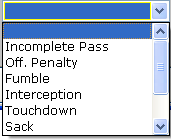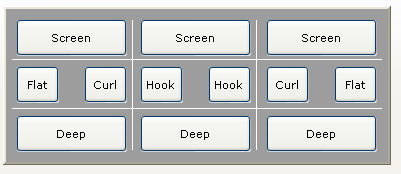|
The Play Entry process in Easy-Scout is designed to make it simple to enter "pieces of information" about each play. Each piece of information is called a "field", which is a technical term for "attribute". Scouting involves recording information about each play for the purpose of analyzing information on the screen and producing reports to determine tendencies and other information about the team that is being scouted or evaluated. Easy-Scout utilizes a number of "controls" in
order to make the data entry process faster and easier. These controls have
technical names like Radio Buttons, Intelligent
Default Values, Pick Lists, Intelligent Lists, Spinners and Image Maps
- and they are combined in a way that dramatically simplifies the process of entering data. INTELLIGENT DEFAULT VALUES In ADD MODE, a "default value" will be "suggested" for many fields based on the information on the previous play. It is easy to "over-ride" default values by simply typing the correct value into a numeric or text field, clicking a different radio button, or clicking the up or down arrow on a "spinner", which is sometimes necessary to compensate for penalties, mistakes, missed plays, etc. There are two types of "Intelligent Default Values": "Snapshot" , or
carry-forward Defaults The following fields use a "snapshot" or carry-forward type of Intelligent Default Value
"Snapshot" Default Values are used for fields that do not change from play to play. CALCULATED Default Values The second type of intelligent default value is "calculated" from the Down, Distance, Field Position (aka Yard Line or Line of Scrimmage) and GAIN/LOSS from the previous play. For example, if, after a game-opening kickoff into the end zone, Play #1 starts on the minus (-) 20 Yard Line, 1st and 10, and ends with a gain of 5 yards , the defaults for the next play, Play #2, will show 2nd down with 5 yards to go at the minus (-) 25 yard line. * It is common practice to apply the minus and plus to field position based on the Offense. So, if the ball is on the Offense's 20 yard line as in the example above, it would be referred to as the -20. Once the ball moves across midfield, the field position is referred to as the "plus" territory (it is not necessary to enter the "plus" sign). The fields that are assigned calculated "Intelligent" Default Values are:
RADIO BUTTONS Radio Buttons are used for the following entries:
PICK LISTS To choose an option from a Pick List, move the cursor to the correct choice, type the first letter of the desired choice then either press ENTER or click the left mouse button, or use the Mouse Wheel to cycle between options. Pick lists can be maintained (customized) by selecting Modify Lists on the Utilities Menu or Toolbar. Pick Lists are used for the following entries:
INTELLIGENT PICK LISTS Items can be selected from an Intelligent Pick List by clicking the arrow and highlighting an option from the list or by typing the first letter of the selection. To enter an item that is not contained in an Intelligent List, simply simply type it in. In cases where part of an item is already in the least and appears to interfere with the process, position the mouse pointer and use the Space Bar to erase the part of the list item that you want to change, and continue typing. When an item is added to an Intelligent List, it will appear as a selection on the very next play. The list of options in the Intelligent Pick List is built from all games that are entered in the system. To remove an item from an Intelligent Pick List, simply delete the game or games in which the item is used and the list will update itself automatically. To change an item in an Intelligent List, use the Search and Replace feature that was introduced in Version 2.0.
SPINNERS Spinners are used for the following items:
IMAGE MAPS
Pass Zone Image Map Note the Hole and Pass Zone image maps are
from a Defensive perspective by default. Flip the reports to view the Hole
Hit and Pass Zone reports from an Offensive perspective. The combination of Radio Buttons, Spinners, Pick Lists and "Intelligent Default Values" are meant to significantly reduce the amount of time required to enter game data. IMPORTANT: It is possible to "Skip" a lot of data entry items (fields) without impacting the functionality of the program. For example, if the Run Details such as the Hole, Ballcarrier position or Ballcarrier number are not recorded or Pass Details such as the Receiver position, Receiver number, Pass Pattern and Pass Zone attacked, are not recorded, the functionality of the application is not impacted. The only effect "skipping" data items will have is that reports will not contain those items. Since many coaches choose not to record the additional Run and Pass Details, these items are located on additional tabs to make them easy to get to and also easy to ignore. It is also possible to control the fields, or data entry items that are displayed on the Play Entry Screen's Header, Main Section and Footer by changing the Application Settings. Application Settings are accessible from the Toolbar and Utilities menu. |



